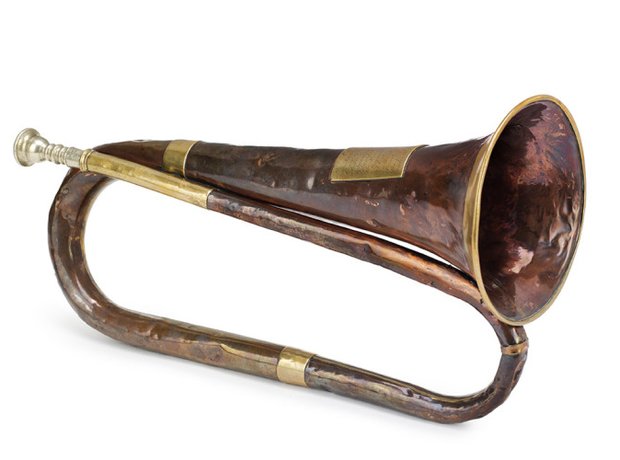Trumpet That Sounded the Charge at Waterloo This field trumpet sounded the crucial charge of the Household Cavalry at the Battle of Waterloo.
This field trumpet sounded the crucial charge of the Household Cavalry at the Battle of Waterloo.At 2.00pm, the left of the Allied defensive position on the ridge of Mont St Jean was under severe attack from the 16,000-strong Infantry Corps of Count D’Erlon. It was a close fight but the French were beginning to break through the Allied line.
Seven units of heavy cavalry in two brigades were formed on the reverse slope of the ridge. Lord Uxbridge ordered his two brigade commanders, Generals Edward Somerset and William Ponsonby, to sound the charge.
This field bugle was blown by 16-year-old, 4-foot tall, John Edwards, who was duty trumpeter of the day. It sounded the charge for the Household Brigade which comprised the 1st and 2nd Life Guards, the Royal Horse Guards (the Blues) and the 1st Dragoon Guards.

The other brigade, the Union Brigade, comprised the 1st (Royal) Dragoons, the Royal North British Dragoons (Scots Greys) and the 6th (Inniskilling) Dragoons. They charged a few minutes before the Household Brigade.
The Allied cavalry manoeuvred through the ranks of Allied infantry and charged D’Erlon’s Corps, with its supporting cuirassiers, causing immense damage. Then, rather than turn back having successfully completed their task, they charged on over the French gun batteries. They arrived without support and with exhausted horses deep into the French lines, where they in turn suffered heavy casualties.

Of the 2,500 cavalrymen involved, approximately half were killed or wounded. However, Napoleon had lost the initiative and failed to gain control of the battle. Two French Eagles (battalion colours) were taken.
Trumpet or bugle calls were a vital command system in battles at this time. Shouting and screaming men and horses, the explosions of guns, cannon shells and small arms made verbal communication impossible. The smoke from black powder meant visibility was down to that of a thick fog. The incredible danger from musket balls, sabres, cannon balls and kicking horses made full attention vital. Only the sound of the trumpet was able to communicate between cavalry squadrons, each of which had a trumpeter.
There were over 40 different bugle calls used in the field, all to command horses. Formations were controlled by calls known to the cavalrymen and made easier to remember by the addition of words in songbooks.
This object is in the collection of Household Cavalry Museum, London: http://www.householdcavalrymuseum.co.uk/










 Similar topics (5)
Similar topics (5)